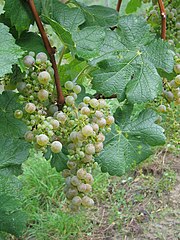Cabernet Blanc
| Cabernet Blanc | |
|---|---|
| Synonyms | no |
| Breeding number | VB 91-26-1, Valentin Blattner 91-26-1 |

|
|
| Art | Grape vine ( Vitis vinifera subsp. Vinifera ) |
| Berry color | green |
| use | |
| origin | Switzerland, Germany |
| known since | 2004 |
| breeder | Valentin Blattner, selection by Volker Freytag |
| Breeding year | 1991 |
| Launch | 2010 |
| VIVC no. | 22355 |
| ancestry | |
|
Cross of |
|
| List of grape varieties | |
Cabernet Blanc is a white grape variety newly bred in 1991 . The variety is one of the fungus-resistant ( PIWI ) varieties. The wines are rich in extract, full-bodied and are reminiscent of Sauvignon Blanc .
origin
It is an interspecific cross between Cabernet Sauvignon and resistance partners. The new grape variety was bred by the Swiss grape breeder Valentin Blattner . The selection took place in the German Freytag nursery in Neustadt an der Weinstraße , district Lachen-Speyerdorf in the Palatinate. After several years of trial evaluation, the grape variety was registered by Volker Freytag for plant variety protection in 2004 and for classification in 2010.
Ampelographic features
- The shoot tip is moderately hairy.
- The growth is strong and upright.
- The leaf typical of Cabernet Sauvignon ; pentagonal with 5 lobes. The stem bay is open to a little open with a V-shaped base. The underside of the leaf is slightly hairy.
- The grape is large, shouldered and loose berries. The berries are small and round, mixed berries, ie normal sized and virgin berries are next to each other. The seedless fruits in particular have a very high sugar content and good extract values. Until they are fully ripe, the berries are dark green and appear unripe for a long time; they only turn yellow when they begin to ripen in early October. The berries have a high tannin content.
The grapes are comparatively small, round and almost seedless. When mature, they have a very high sugar content and extract values. The berries are dark green and look unripe for a long time. With the beginning of ripeness, usually not until the beginning of October, the berries turn yellow.
Ripeness: mid-late October
Yield
Because of the strong tendency to trickle , the yields can vary greatly depending on the location.
Expectations
Because of the strong tendency to trickle, the variety should only be grafted on a weakly growing substrate.
Advantages and disadvantages
advantages
- The variety has good resistance to Oidium and Botrytis .
- The grape has normal-sized and virgin berries. As a result, the grapes are rather loose, airy and easily drying, which has a positive effect on the resistance to botrytis ( gray mold rot ).
- Has good resistance to the real and downy mildew of grapevine .
- The winter frost resistance is very good - comparable to Riesling .
disadvantage
- Is very sensitive to bloom, so damage caused by trickling is possible.
Wine
The wine is complex, spicy, rich in extracts, the bouquet is similar to Sauvignon Blanc . The taste is often compared to Riesling or Sauvignon Blanc .
literature
- Karl Bauer, Ferdinand Regner , Barbara Schildberger: Viticulture (= AV book. ). 9th, updated edition. Cadmos, Vienna 2013, ISBN 978-3-7040-2284-4 .
- Jancis Robinson , Julia Harding, José Vouillamoz : Wine Grapes. A complete Guide to 1,368 Vine Varieties, including their Origins and Flavors. Ecco / HarperCollins, New York 2012, ISBN 978-0-06-220636-7 .
Web links
- Cabernet Blanc in the database Vitis International Variety Catalog of the Institute for Grapevine Breeding Geilweilerhof (English)
- Variety description from the Freytag nursery
- Cabernet Blanc on the grape show
Individual evidence
- ↑ a b Jancis Robinson, Julia Harding, José Vouillamoz: Wine Grapes. A complete Guide to 1,368 Vine Varieties, including their Origins and Flavors. Ecco / HarperCollins, New York 2012, ISBN 978-0-06-220636-7 , p. 148.
- ^ A b Karl Bauer, Ferdinand Regner, Barbara Schildberger: Weinbau (= AV-Fachbuch. ). 9th, updated edition. Cadmos, Vienna 2013, ISBN 978-3-7040-2284-4 .
